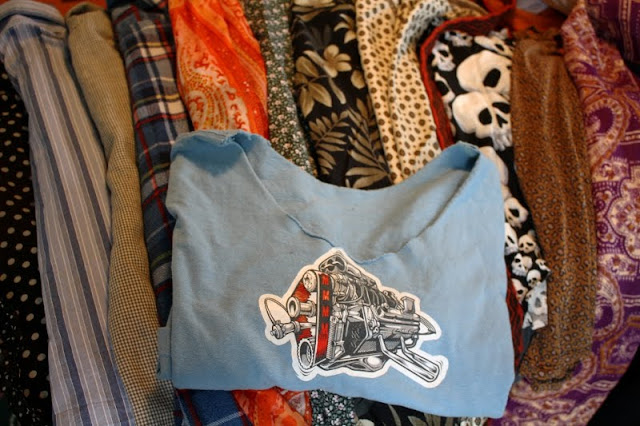As far as I'm concerned, the biggest rule - the only rule, really - in fashion is "To thine own self be true." I was going to say "don't get arrested for not covering up certain bits," but maybe you have perfectly valid reasons for racking up an indecent exposure charge. Civil disobedience? Performance art? A social statement about the gendering of our bodies? It is not my place to judge.
I also kind of want to say "speaking of exposure, dress appropriately for the weather," but considering how often I've frozen because of a clothing choice more dictated by aesthetics than practicality, and my fondness for tall boots and velvet year-round, even in summer, I can't, not without courting hypocrisy.
So. "Rules," or at least my own aesthetic, for anyone who is interested. Not, please, to be taken as gospel.
Let's talk about patterns.
Color covered a relatively narrow spectrum (sorry) of possibilities. Patterns get a lot more complex, because we're dealing with all the possibilites color gave us plus formal (shape-related) issues as well.
There are a bunch of different characteristics patterns can have. Let's define some terms:
- Motif: The building block of a pattern, which can be as simple as a line (put a bunch of different-colored lines running in the same direction together, and you have stripes) or a complex, multicolored design. Motifs can be large or small, geometric or organic, figural or abstract, colorful or monochrome.
- Repeat: How the motif is repeated across the fabric. One complete cycle of an entire motif is "a repeat." Repeats can be vertical, horizontal, or both (Our stripes have either a vertical or horizontal repeat, depending on their orientation. Plaids have both. A graphic tee with a single, large central image has a single repeat).
- Scale: This is related to both motif and repeat size. Both a large motif that repeats only a few times and a large repeat made up of many small motif elements are "large scale."
- Color: The same concepts about color mixing discussed earlier apply, with the added bonus that a print may combine colors you'd never think of mixing, either providing inspiration or a way to tie together disparate elements.
- Contrast: How the elements of the pattern relate to one another. A black-and white pattern with large motifs is very high contrast: the same motifs at smaller scale, or the same pattern in black and dark grey, less so.
- Structure: Because we're dealing with the visual impact of patterns, this characteristic is less important for the purposes of this discussion than the others. It is good to know, though, that patterns can be created in various manners: they can be woven, knitted or crocheted into the fabric, printed or dyed on, or even sewn on (applique). Some "patterns," such as ribbing or tweed, are the visual impact of a mainly textural structure.
Up until recently, I tended to wear only one patterned item in an outfit. Aren't mismatched patterns the epitome of clashing? Then, for whatever reason, I started to play, and discovered that multiple patterns in one outfit can work very well indeed.
The trick, I've found, is to let one pattern dominate visually. If you put two large-scale, high-contrast patterns right next to each other, you usually get the canonic eye-watering effect:
So let one of the patterns dominate, and keep the other pretty subtle:
I've done this before, pairing a pink-and-black skull tunic with a tone-on-tone polka-dot miniskirt; big hearts and tonal stripes; and leopard, tweed and lace.
As you can see, I prefer to keep the non-dominant pattern tame by making it tonal (i.e., multiple shades of the same color). There's no reason not to experiment with multiple multicolored patterns, though.
Another great option is to separate two relatively strong patterns with a solid color, like unruly children in preschool.
For today's outfit, I did a bit of both!
Trench shrug: Ann Taylor Loft
Silk foulard scarf: from mom
Teal tee: Mossimo, hand-me-over from a closet-cleaning friend
Polka-dot skirt: Ann Taylor Loft
Burgundy striped tights: Spanx, TJMaxx
Wedges: John Fluevog, Pinups family, forget the style name
Open-toed shoes demand patterned tights, at least for me. I like the contrast between the very subtle tone-on-tone stripe of the tights, the punchy polka dots (in two sizes on the same skirt!) and the very conservative foulard square.
How do you like to mix patterns?











I love learning all about pattern characteristics. That's awesome!
ReplyDeleteSadly, I don't do much pattern mixing. Solids are so simple, and I like things to be effortless. Plus I'm super jazzed about color, and patterns are just less interesting to me. That said, I guess I am wearing a gingham shirt and zebra print shoes today. Hm.